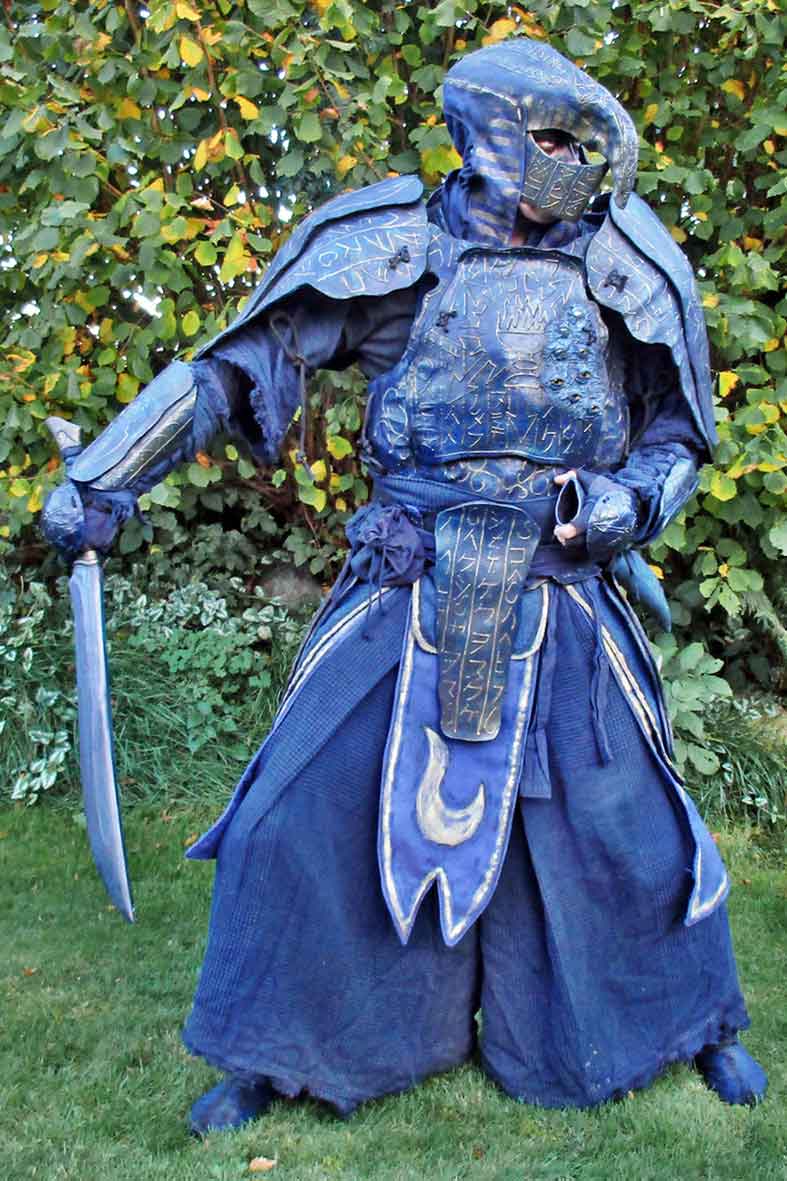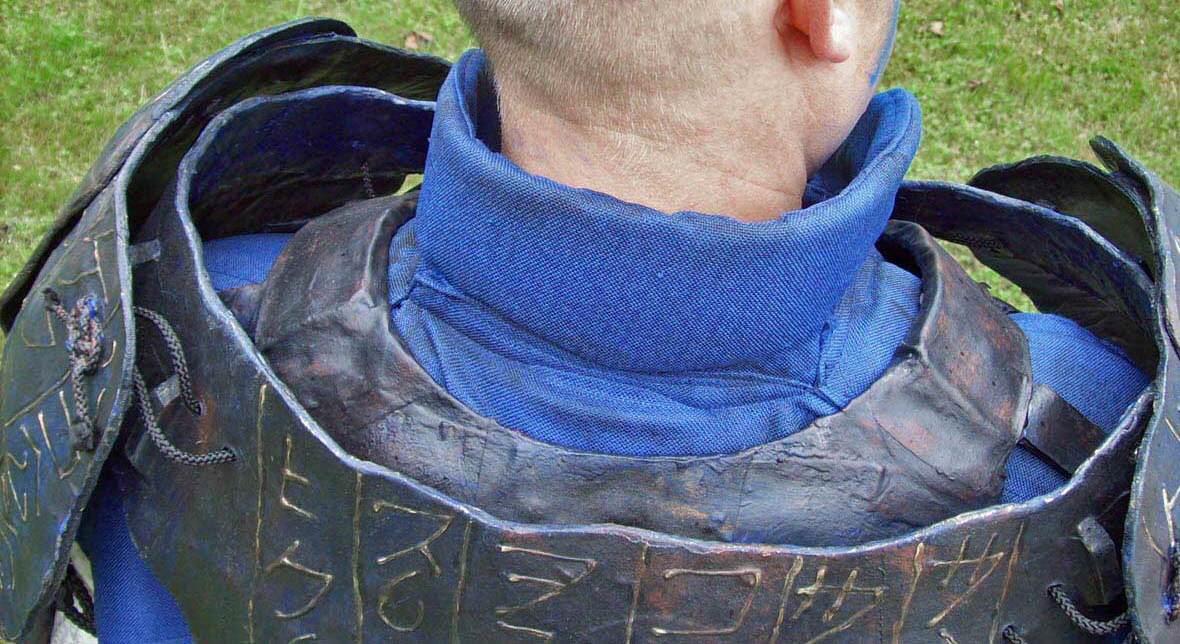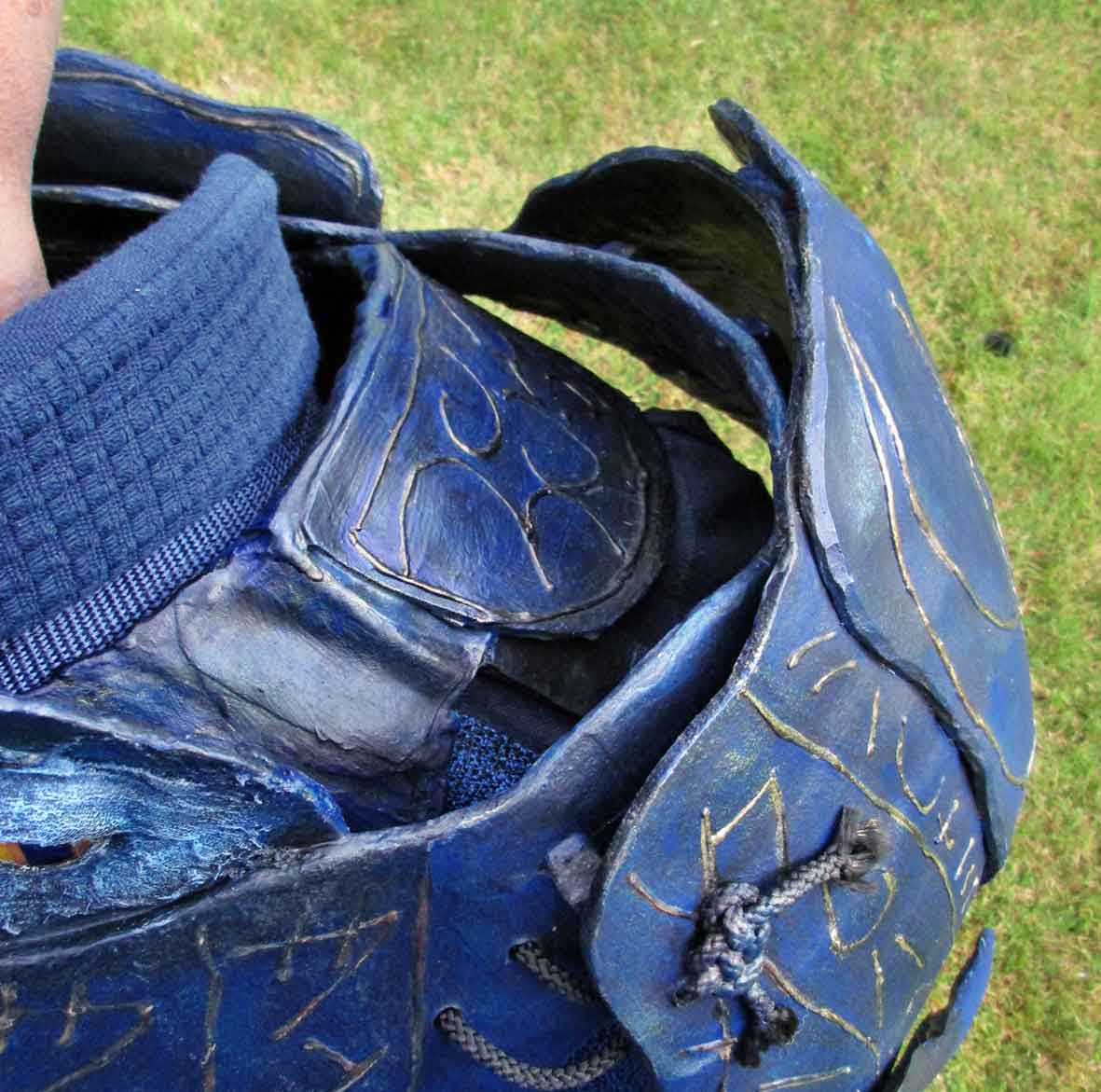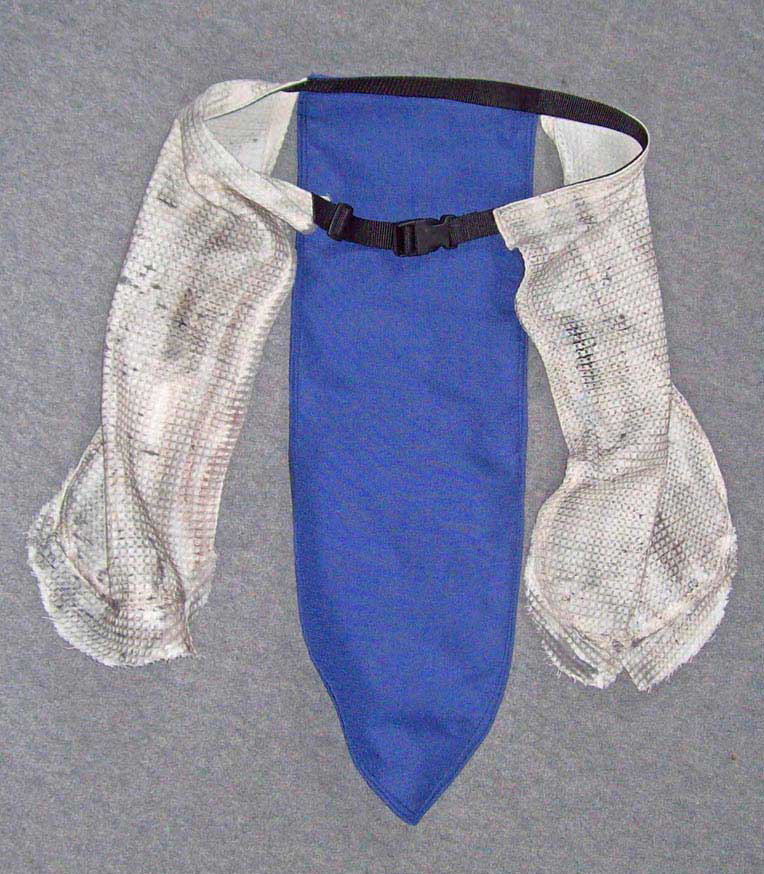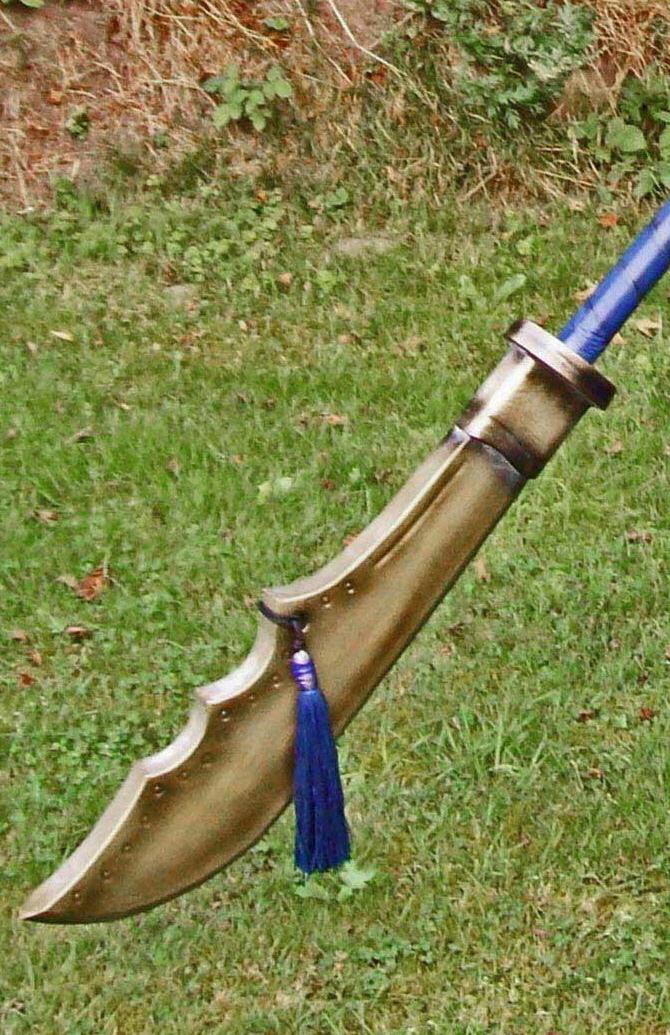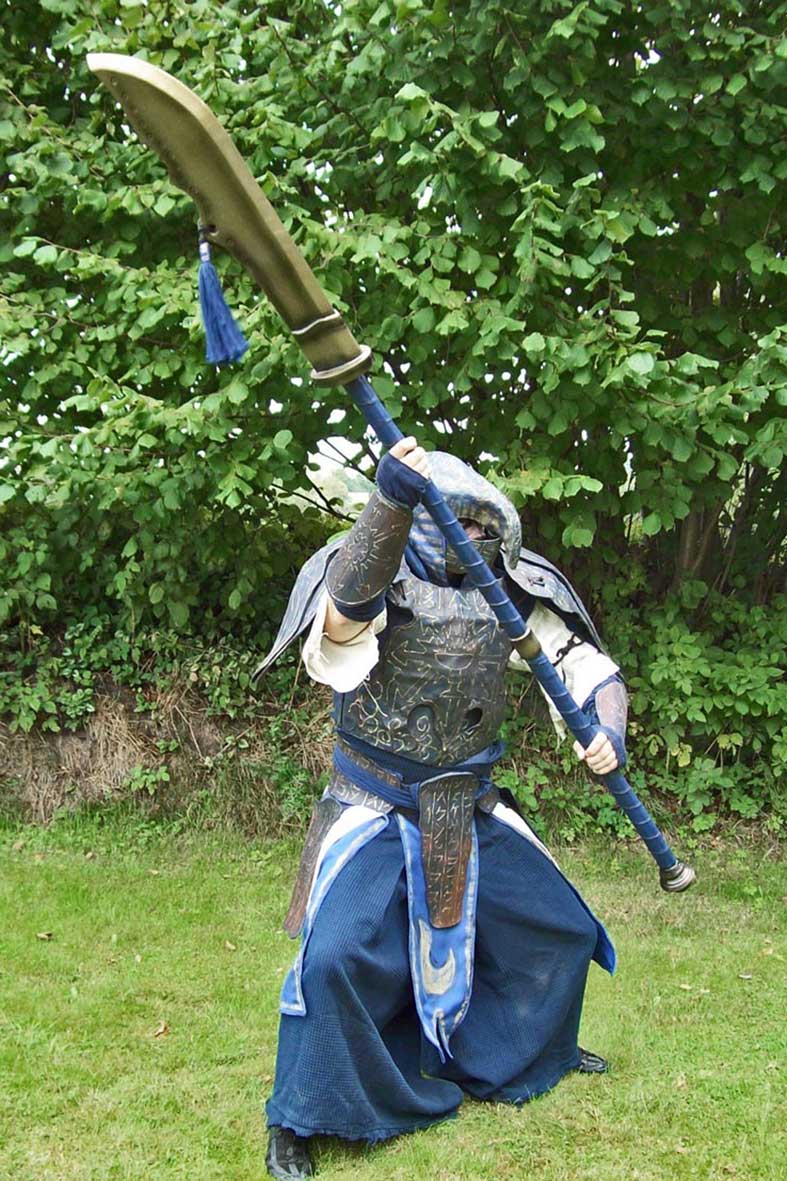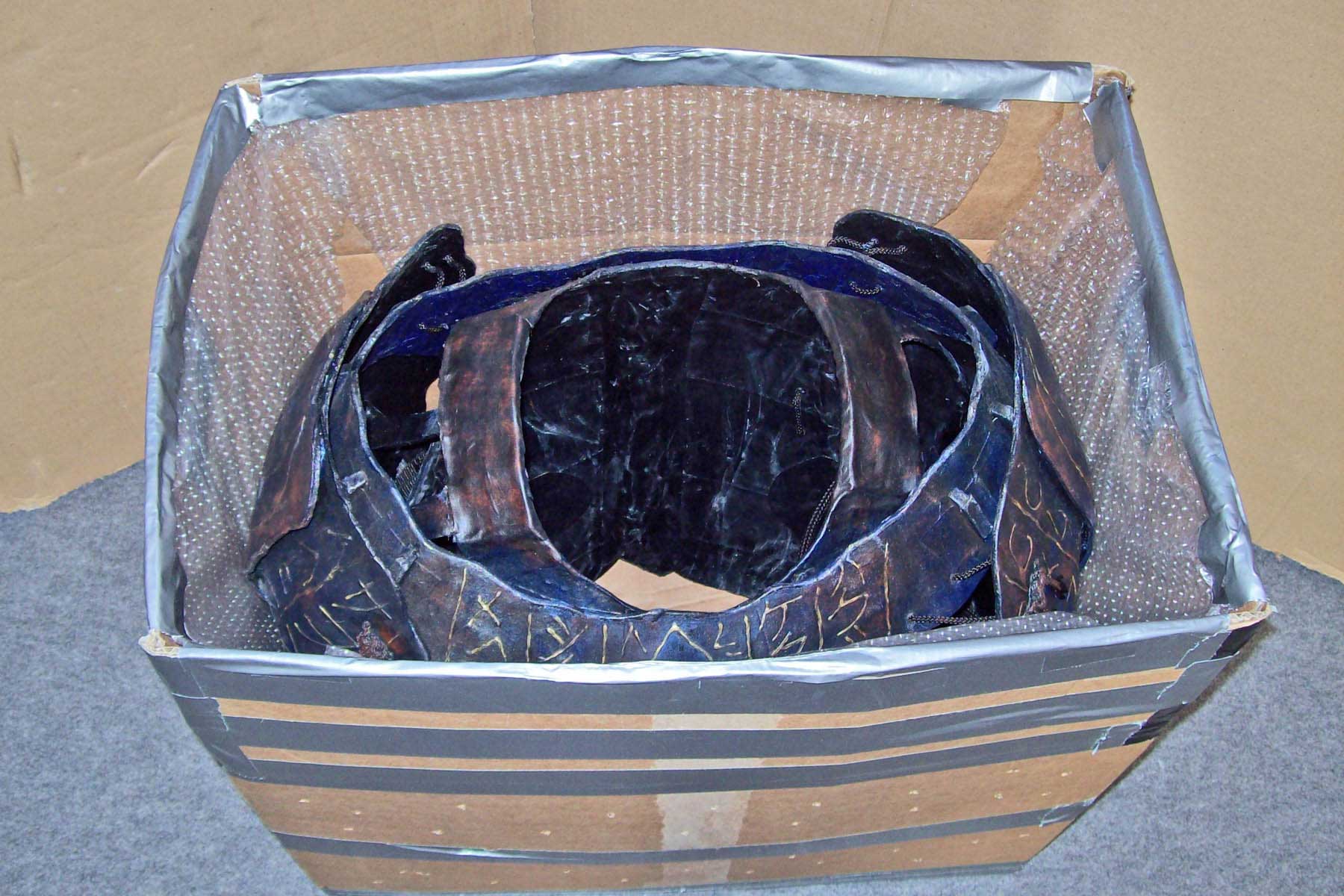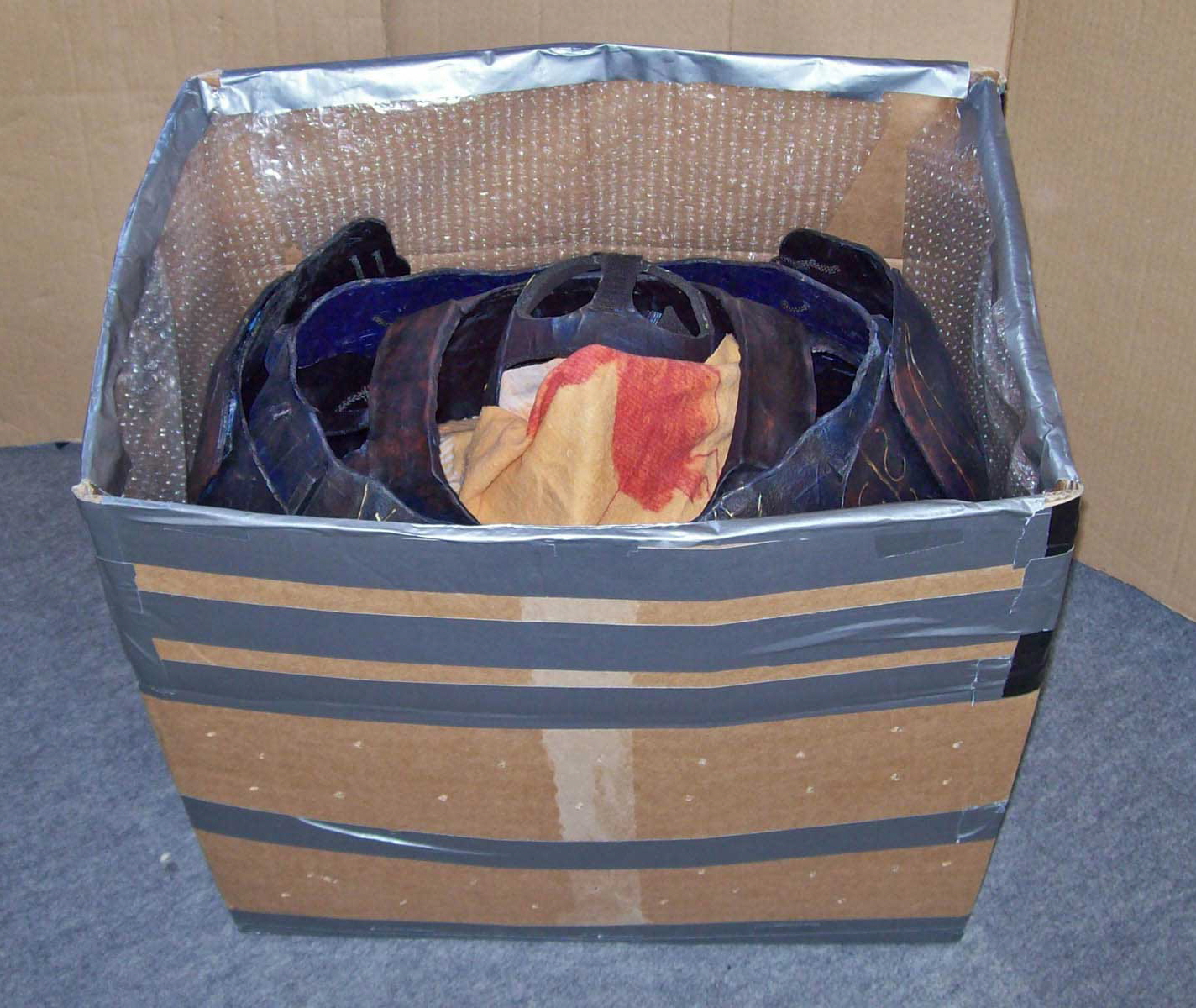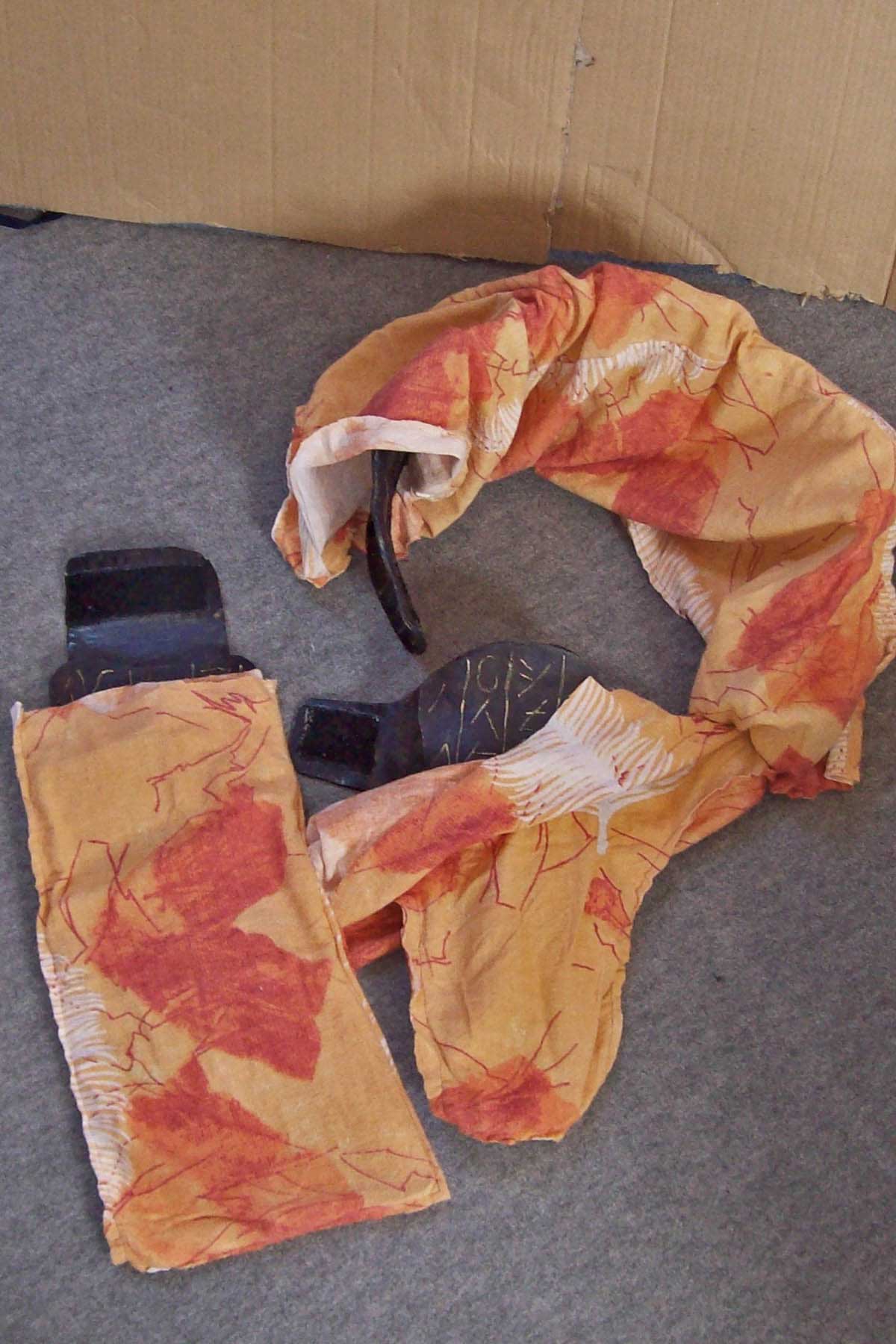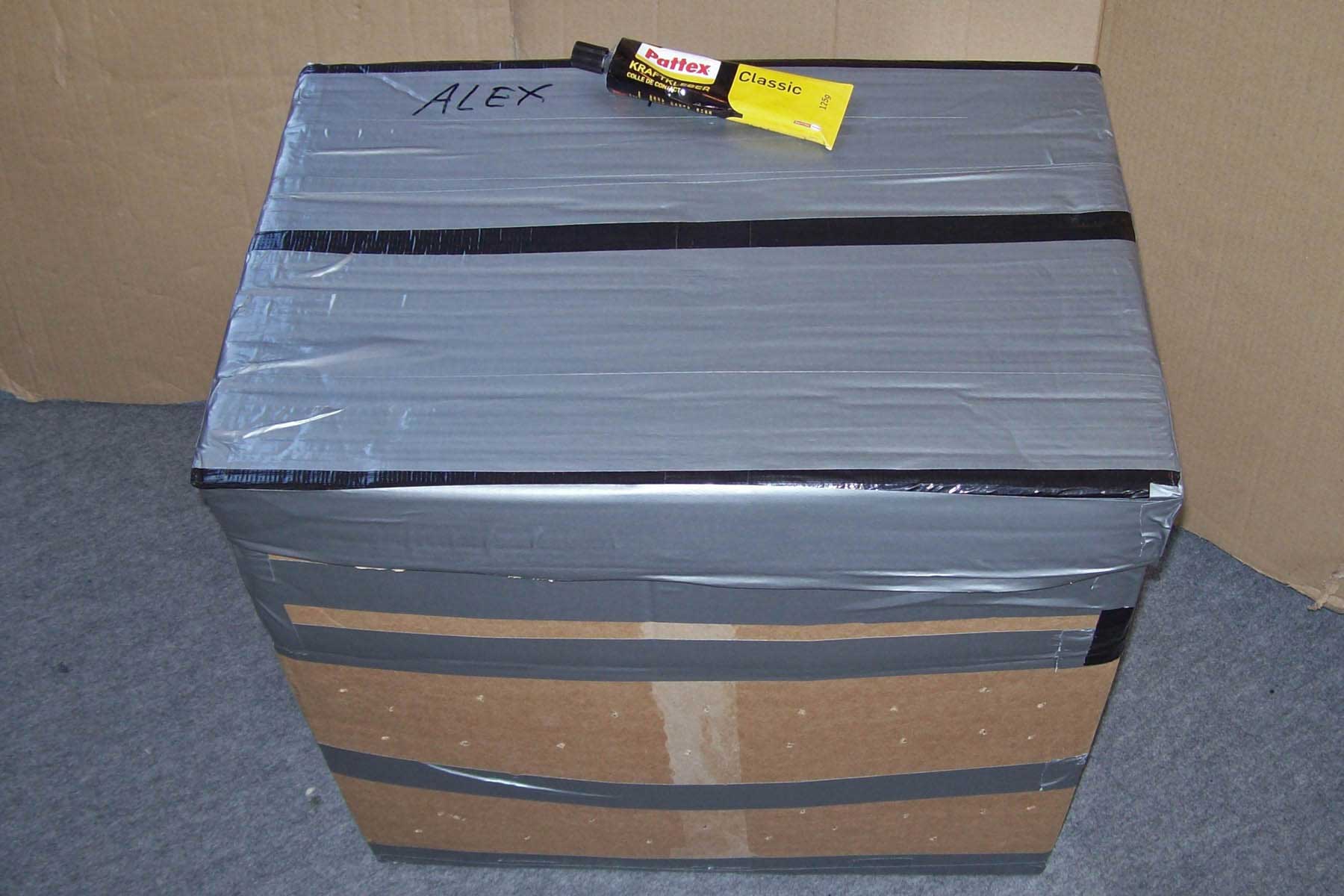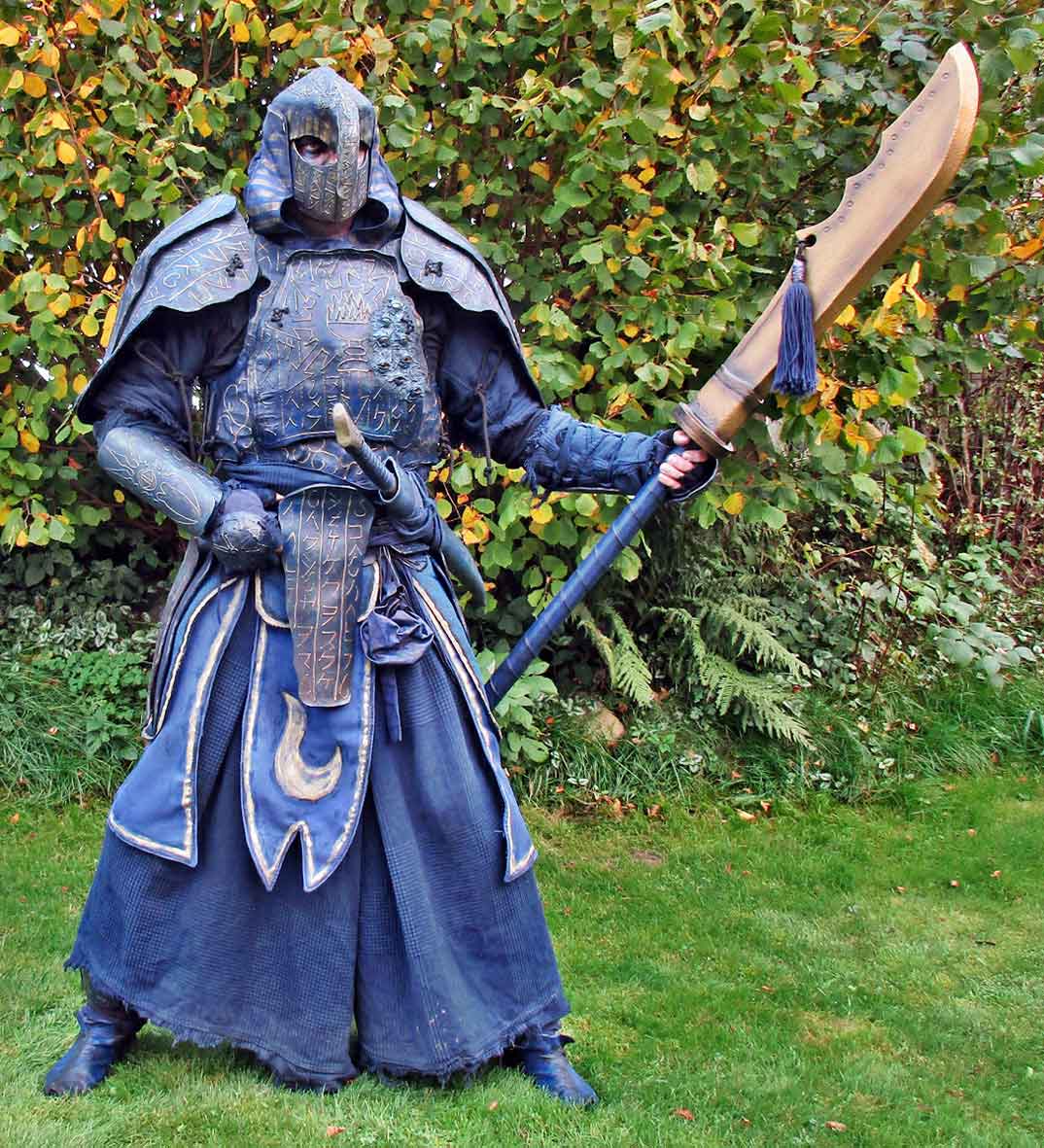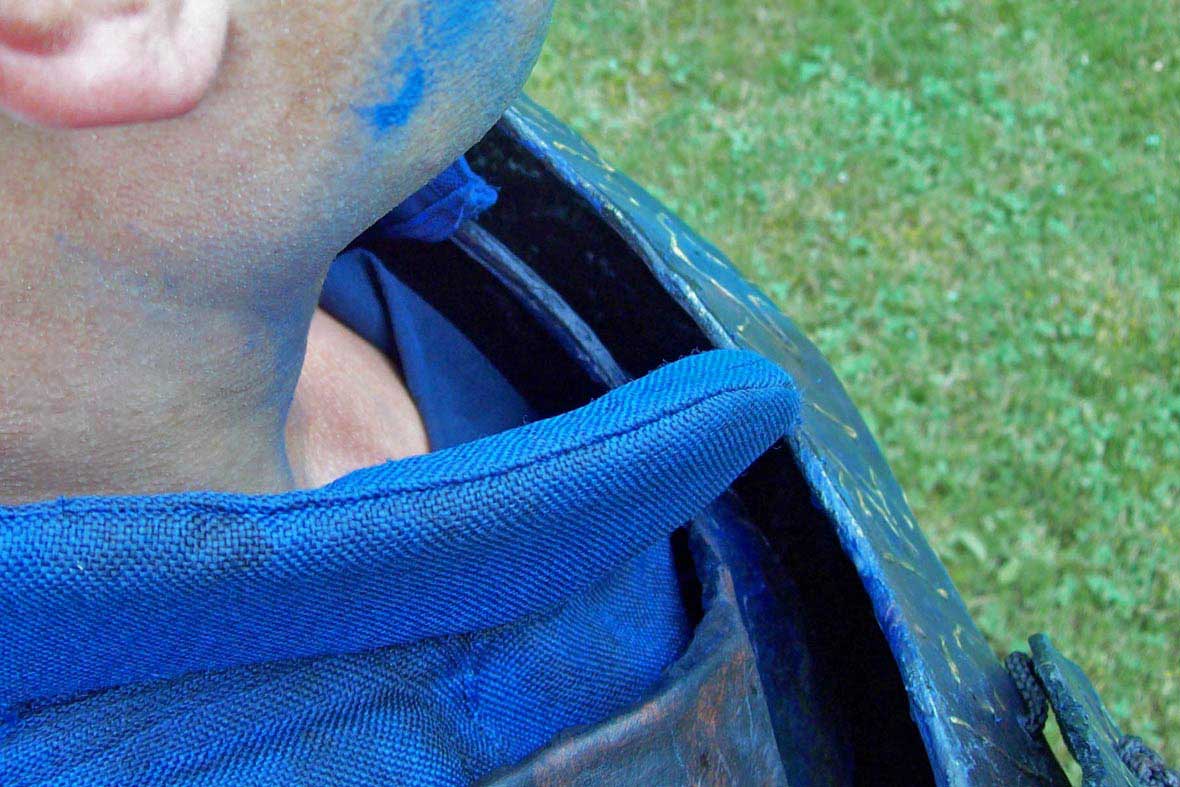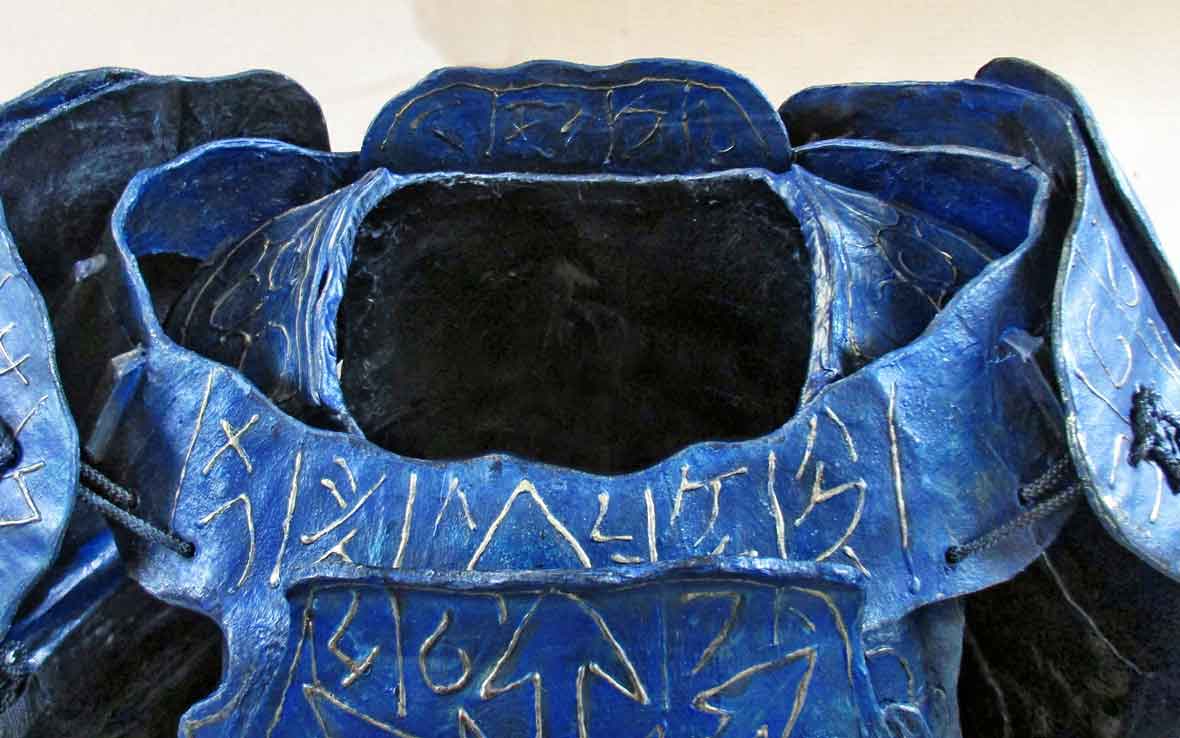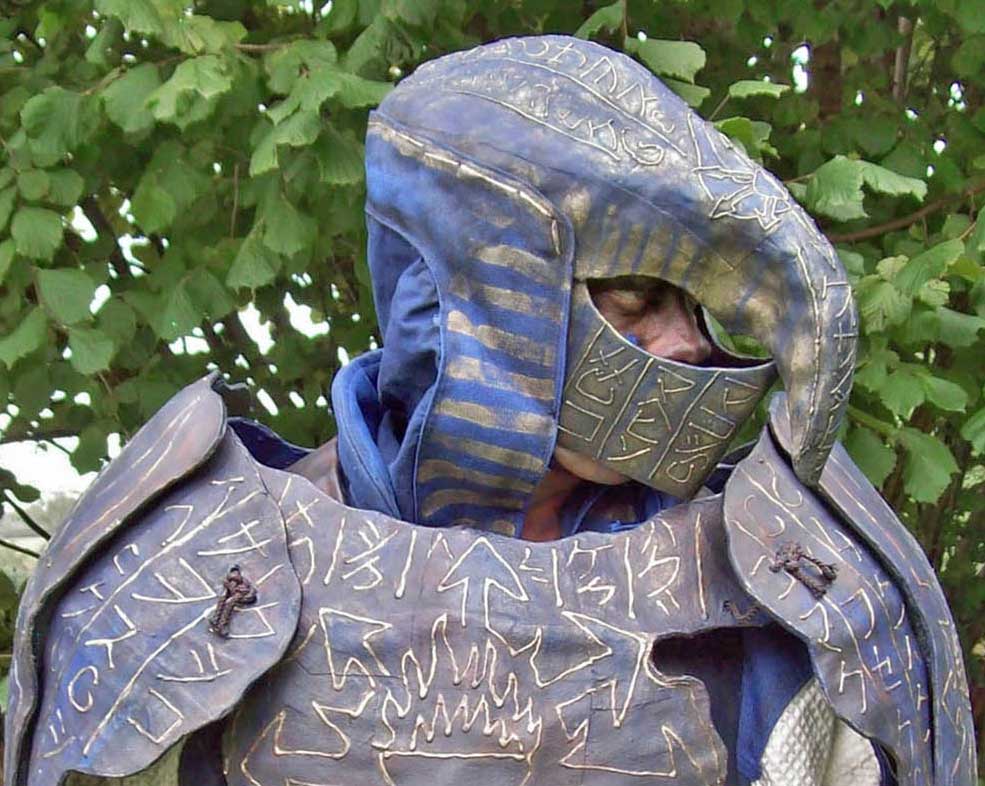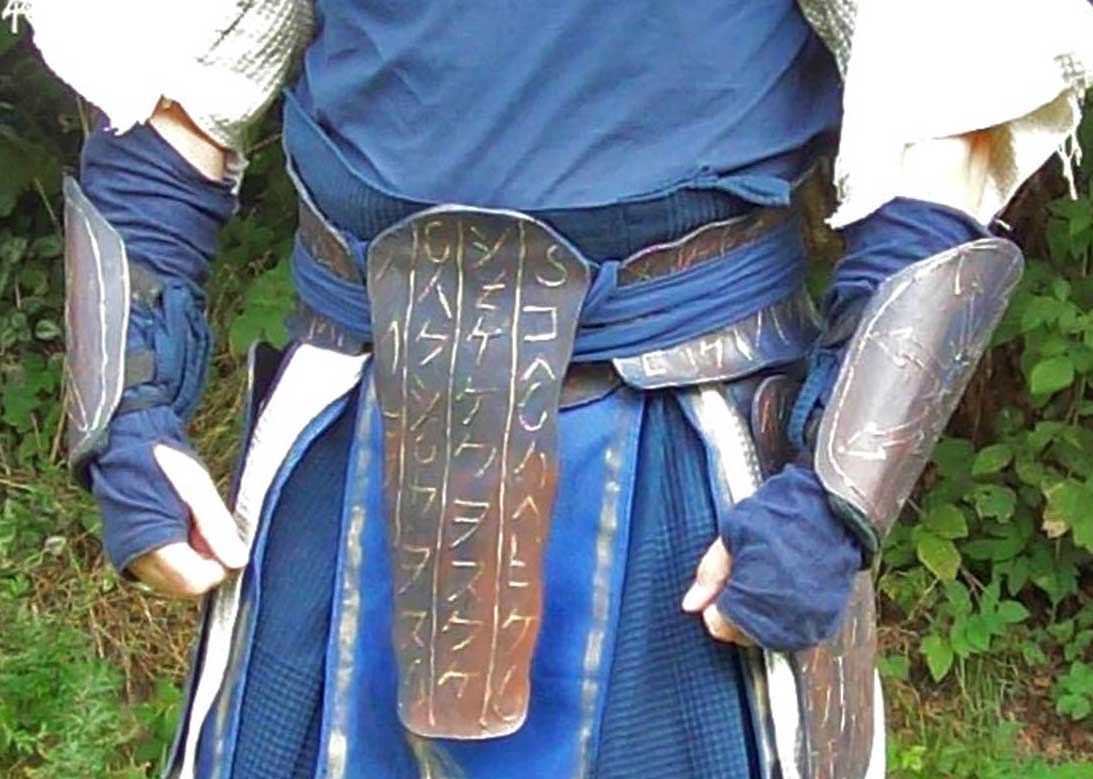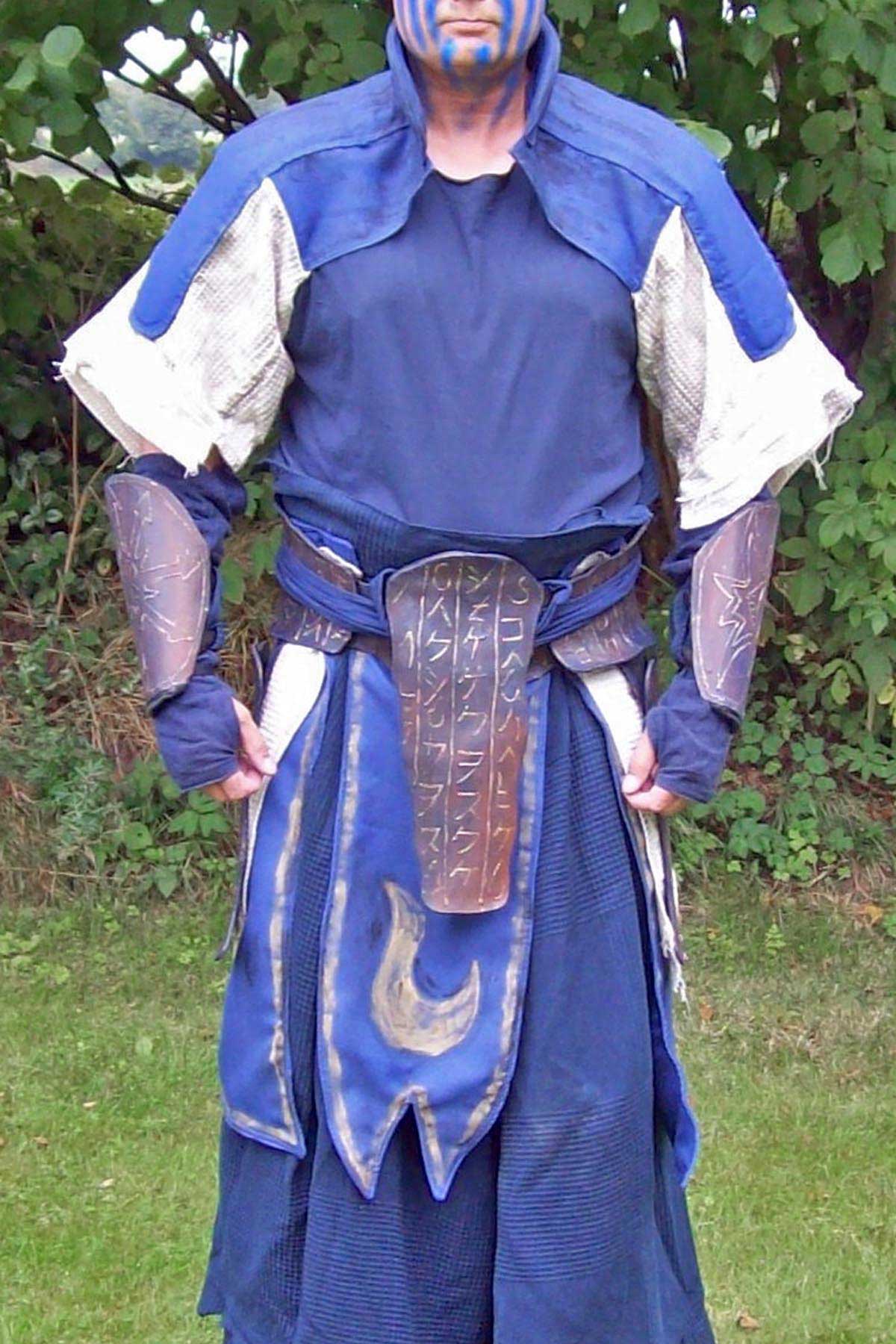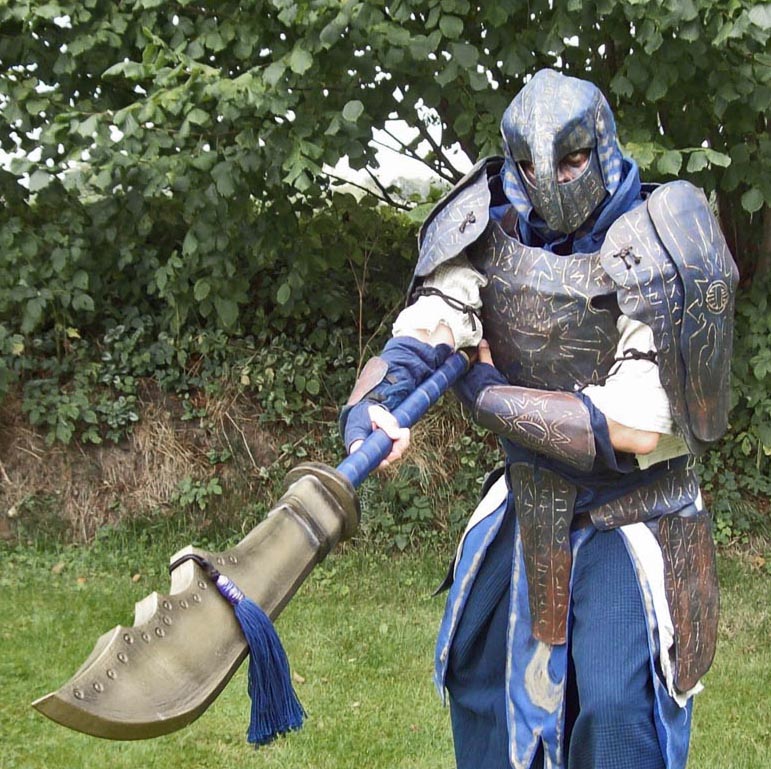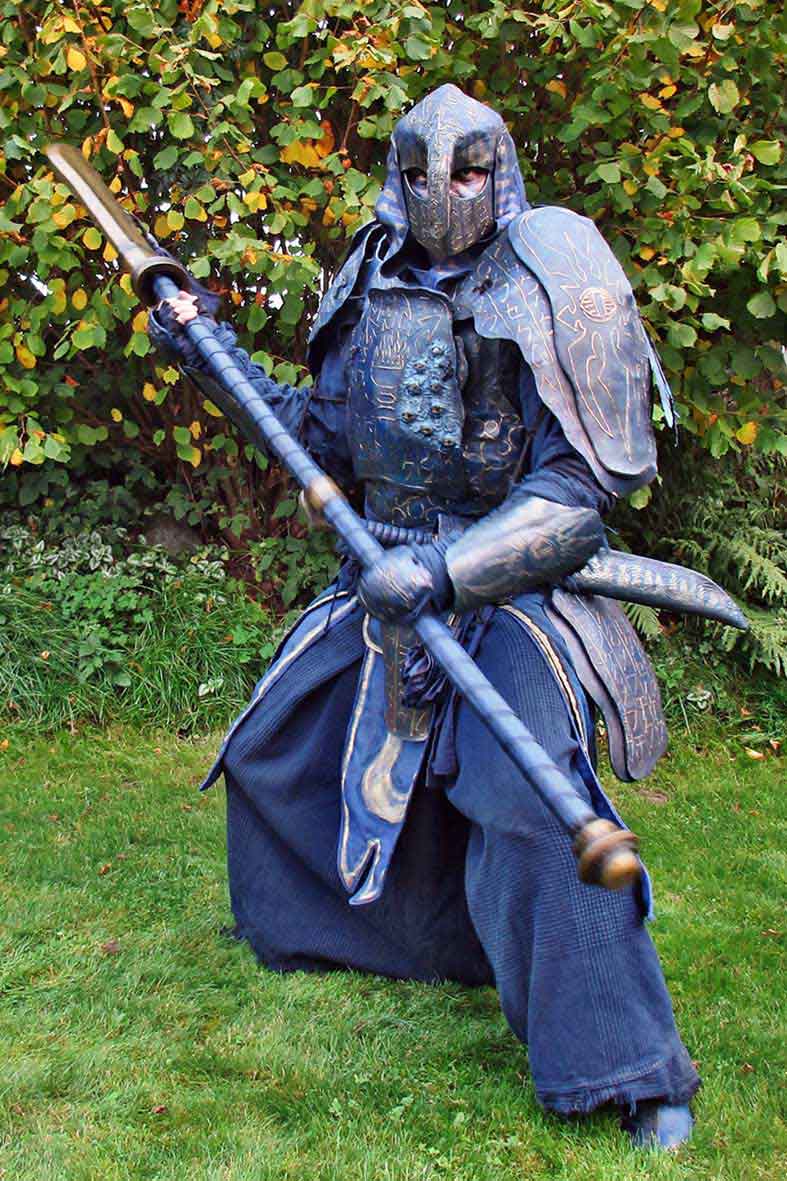|
|
 |
 |
|
 |
|
 |
|
|
|
Functional double- walled body- armour made of layers of glued cloth, Epic Empires 2014
This page is about the construction principles of my “linothorax”- composite- armour. The introduction to the subject area would be here: composite armour.
Although diverging quite a lot from the classic greek tube- and- yoke- pattern I would like to call this armour a linothorax because of the ingredients that were used to build it.
The construction specifically utilizes the materialīs flexibility to create impact- resistant, cut- and stabproof plates. Not bulletproof, though (steel armour isnīt, too, by the way).
|
 |
|
|
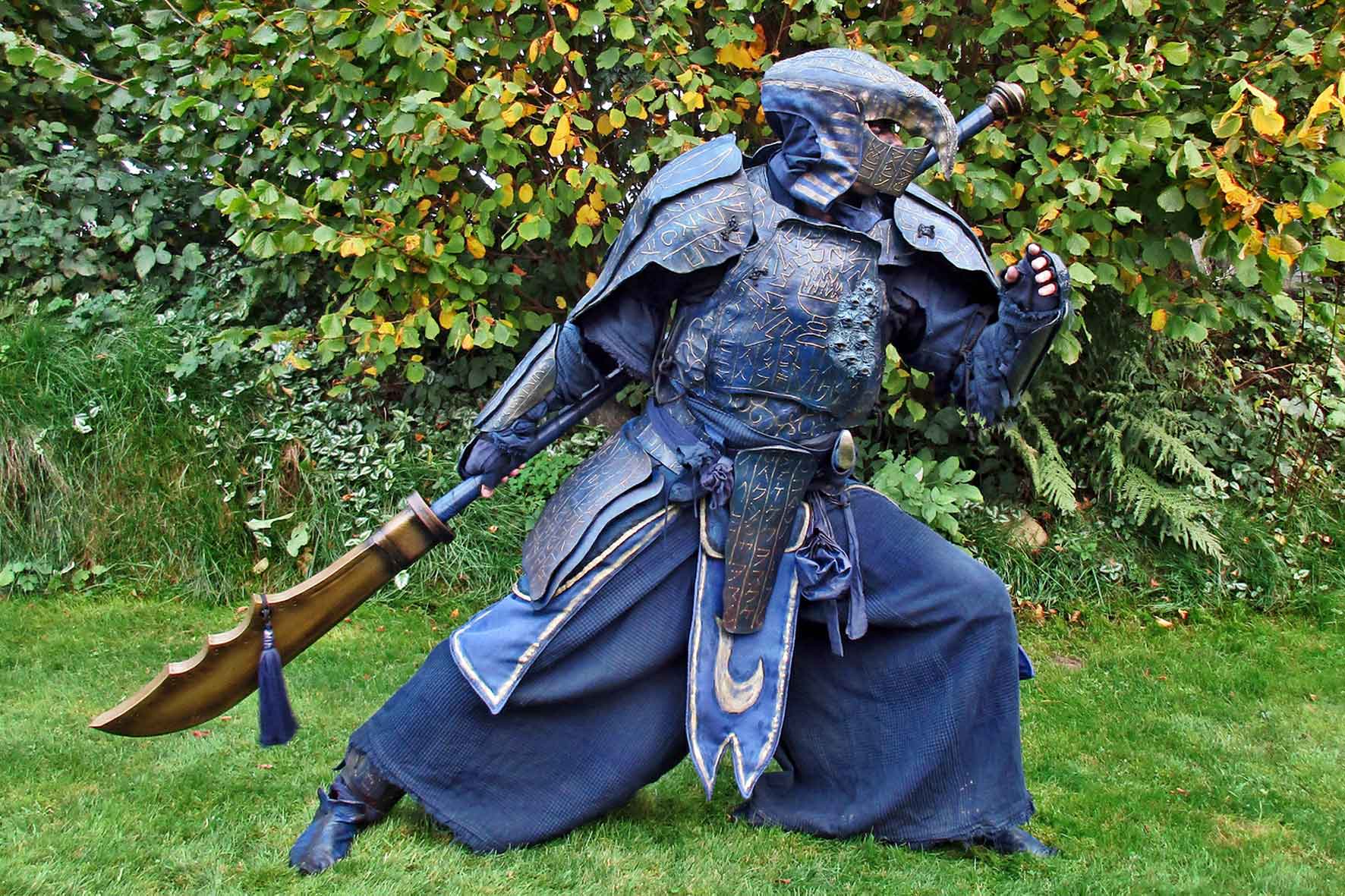 |
 |
 |
|
From now on Iīll also use the word for the material itself and worse: even abbreviate it “lino”. First thatīs because everybody else around here does it too and second “composite material made of glued- together layers of linen” sounds like a... waste of valuable internet-space.
“Lino” for fantasy- larp of course is less on the side of serious reconstruction- the look is what counts. After all, we also use polyester sewing thread, sewing machines, chrome- tanned leather, modern steel and Pattex.
For building linothorakes today we have access to cotton linen and waterproof D3- glue, so without remorse letīs put mercy before authenticity and repair to the next DIY-store.
|
 |
 |
|
And why didnīt I build a classic linothorax but instead put up such an odd thing?
Meanwhile that Iīve seen a “real” one I am sorely tempted. What a practical piece of equipment! I think Iīd like one....
For this campaign though I wanted “something entirely different” (a chaos warrior) and knew in advance that we wouldnīt come up just against ancient hoplites but also armoured vikings, medieval knights and ironclad imperial paladins- not to mention hordes of orks, warlike elves, landsknechts and trigger- happy musketeers (luckily not all together; at least not always).
Insofar “more plate” seemed to be a good idea.
So what is this for a peculiar suit of armour?
A temple guard. Obviously to be seen on first glance, or wot?
These chaps mostly hang out in the background of the scene wearing more or less extravagant outfits. They are ordered about by their respective superiors with shouted commands like “Avaunt! Find them!” or drag folks around at “Avaunt! Take them away!”
|
|
|
 |
 |
|
Time and again they fall prey to a hero creeping up on īem if -as they so often do- wear helmets they canīt see anything in. Mine however has an optimized field of vision, in which case the line is: “My Lord, we have caught this intruder at the gate/ under the table/ wherever”:
They are specialists in baring oneīs way with crossed halberds and the millenia- old challenge: “Oi! You! Who are you and what do you want?” and generally make the boss look good, take care he gets through crowds unhindered and hasnīt to kill people he doesnīt like all by himself; or the other way round can unimpededly cut the throat of the fellow on his altar.
Great job, innit?
|
|
 |
 |
|
This specimen wears colours and symbols of one of the gods of chaos from the Warhammer- universe which in all objectivity makes him one of the bad guys.
Iīve already worked with lino in spring (2014) and am so fond of its qualities that this time I wanted to try and build a suit of armour only with cloth and glue that nevertheless protects against real weapons, although this would of course not be necessary for larp purposes.
I deliberately refrained from strengthening it with metal elements and also forego the use of foam parts, horns and spikes. The idea was not to see the materialīs flexibility as a weakness but to take advantage from it.
So my linothorax differs from its antique paragon not only in its shape but also in the way it is constructed. Iīd like to explain these features here but show the actual building process on separate pages so you donīt have to scroll for miles to find anything.
Thatīs why the documentations of helmet, harness and add- ons branch off from here. The links lead straight there but theyīll also reappear at the end of each page so you can read through the whole thing without having to navigate my confusing menu:
Helmet: Lino Helmet
Harness: Lino Harness
Add- ons: Lino Add-Ons
The armour is inspired by asian panoplies. Iīll mention the names of the respective original parts although not much remains. Early japanese suits had solid harnesses and very big shoulder plates. Samurai armour got more flexible over the years and the plates became smaller ; only horsemen retained the bigger ones. This must have had reasons, but I stuck to the older design.
Additionally my suit has no 2D- plates, meaning all components are more or less curved. This increases stability and directs flexibility into the right channels.
Solid single- piece harness “tanko” with big shoulder plates “o-sode” with built- in crumple zone:
|
|
|
 |
 |
 |
|
Front, back and shoulder plates are built double- or 3-walled with space or padding between them.
An impact- event must therefore first compress both tiers (which already uses up a lot of energy) before penetrating two “walls” of highly resistant armour both of which could stop a blade for themselves.
This flexible “crumple zone” combined with the materialīs toughness equals the resisting power of traditional metal armour but its functional behaviour is more resemblant of modern-times body protection.
Front and back are one single component with non- detachable shoulder plates. Hinges are not necessary because the materialīs flexibility allows for simply bending it apart when dressing the armour.
The bottom layer consists of convex sections whose recesses form the areas of movement of the construction when the harness is bend by force. Thus it only folds where no harm is done instead of denting where it would hurt.
|
|
|
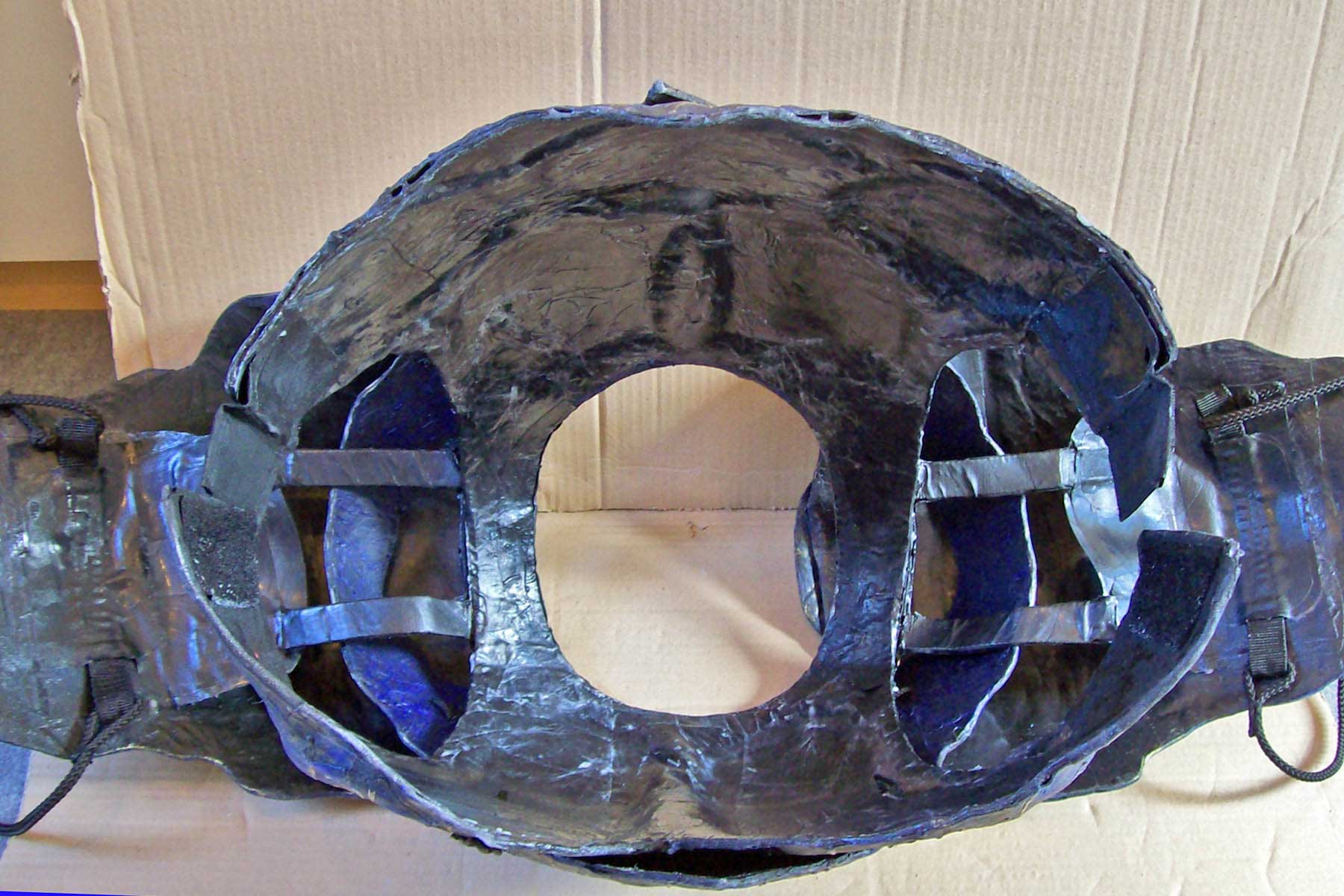 |
|
 |
|
|
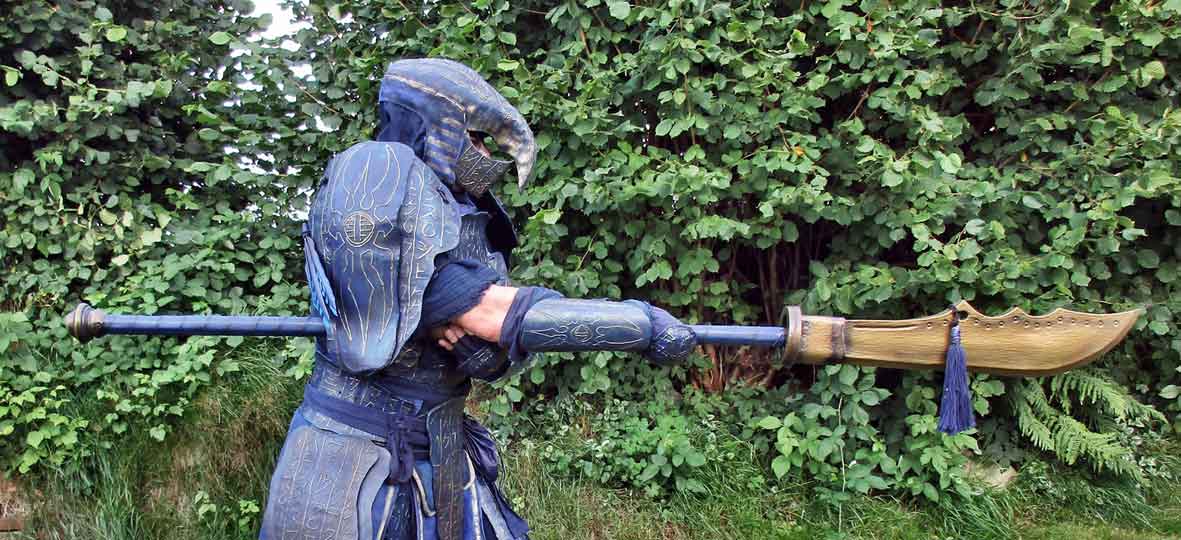 |
 |
 |
|
upper shoulder area:
The way the shoulders are built has no example that I know of. The relatively open design of the armourīs outer “collar” is my solution for coping with the materialīs flexibility; besides, it facilitates ventilation. I decided against the classic concept of relatively flat- lying plates on bolsterwork (which, curved or not, would dent in) and instead built multiple layers of armour in a tilted angle with airspace in between. These will of course also deform when hit (eating up energy in doing so) but never even touch the shoulderīs padding.
Thus despite the flexible nature of glued layers of linen the overall structure retains its impact- stopping capabilities, again using the “crumple- zone”- principle.
Above right: the next building phase sees a 3rd frontplate, neckguard and inner shoulder plates which close the construction, creating a coherent surface against impacts from above.
The side plates each rest upon a row of wooden separators to minimize abrasion. This area where outer collar and plates rub is not visible from the outside.
Two straps lead from the shieldīs middle forward and behind the shoulder and attach to the inner collar that is part of the armourīs bottom layer.
There are also two loose cords “tsuru/ kumihimo” on each upper side of the shoulder plates (the one on the rear left is in view). These cords limit the plateīs range of motion and stabilize the shoulder area. They only tighten with certain movements.
If the shoulder is hit the impact would first have to compress both side plates and the collar to transfer enough energy through two layers of padding to cause an injury.
Something that can hit me strong enough to achieve this shouldnīt anyway be taken on with a “stand fast” tactic; super- armour or not.
Weight of the armour: negligible 6 kilogramms.
After wearing it for 13 hours one is of course glad to get out of it- but what other armour can be worn for such long periods? When somebody invents a bulletproof vest in real - life that is still comfortable after a 13- hour- duty Iīll marry him.
The “outer collar” (below right) is defined by the movement zone of the helmet who must never touch the harness. When an arm is raised the respective shoulder plate forms another layer of armour, closing with either the neck padding or the helmetīs rim.
The seemingly big “clearance” is necessary to enable the armourīs parts to work together: even tailormade, perfect fitting panoplies can and will move on the body up to a handīs breadth, which during extreme motions can even injure the wearer: one for example has to know exactly the circumstances under which the harnessesīs upper rim or the the armourīs collar come up and can touch the throat (yes, they can do that, albeit they wonīt while the warrior is posing in front of a mirror- so go out and practise with your equipment- preferably in a sufficient time frame before the battle starts).
|
 |
 |
|
The helmet also has no historical background but despite of the unusual shape it is more functional than one would expect:
There is no “front face” as with a normal helmet and the protruding “beak” prevents that after an impact a forward edge can hit the bridge of the nose or or a nasal strap is knocked into the face- both sorts of accident occur quite often even on the battlefields of the game- worlds.
A lateral strike will only slightly shift the helmet. It can be worn with or without chinstrap.
Sight is very good but the openings are small enough to stop a larp- arrow (which has a cushioned head). The inner padding is integrated and the cloth at the back is pervious to air.
|
|
|
 |
 |
|
I think generally helmets should be as lightweight as possible. Of course they have to be impact- resistant and padded, but if in a fight the side of the head is hit strong enough youīre out regardless how heavy your helmet is.
|
|
|
 |
 |
|
Part of the suitīs movement concept is separation of upper and lower body armour. So the harness which only covers the ribcage is complemented by a super- broad belt (on the left the first version from 2014).
Belts over 4 fingers wide are malicious because they will hinder your movement: worn high youīve got a kind of corset but too low it will obstruct the legs.
My solution in this case is to give the armoured belt the form of a life beltīs inner side: although broad it is curved outside to facilitate the upper bodyīs movements that are so essential when fighting. The flexible outward-bent edges also serve to cushion impacts.
|
|
 |
 |
|
The front of the belt consists of a lower waist plate and a hard but slightly flexible “breechclout” that serves to protect vital lower regions.
Over the armoured belt a double- wrapped cloth- belt “obi” stabilizes the whole arrangement and serves as a mounting for small pockets or sidearms. The obiīs knot is under the front layer of the “clasp” and helps to separate the elongated front sheet from the lower abdomen plate, thus effectuating the suitīs “crumple- zone” philosophy.
Nevertheless a certain padding under the belt is necessary: it is provided by multiple folds of the undergarments: the japanese pantskirt “hakama” and the sideward cloths; thus up to 12 layers of fabric serve to pad the belt.
Vambraces and cuisses (= shin- and underarm- plates) “kote/ suneate” in the earlier version consisted of metal parts that were only covered with one layer of cloth (for the look) and the lower side plates “haidate” that protect the thighs were of course inadequate; time was running out (again).
|
 |
 |
|
right: the finished version (2015) with composite vambraces, hand protector and double- layered sideplates:
the belt is only one- layered, but the transverlsely- worn “asiatic” sword- sheaths make it impervious.
Building such a belt in metal or leather would be very complex. The shapeability of layers of glued cloth and the resulting flexible but impenetrable composite mono- part is a good example for this exceptional materialīs strengths.
|
|
|
|
|
 |
 |
|
Like its very distant japanese relative the ensemble is designed for operation in hot and wet climate (and the summer campaign met these standards perfectly...)
Concretely that means light, quick-drying clothes and padding only where absolutely essential- with concessions to the protective qualities of the garments.
You canīt have everything.
Under the wide pantskirt “hakama” cloth gaiters “kyahan” either pad the leg armour or encompass the lower part of the garmentīs legs to wear the cuisses as outer layer in difficult terrain.
The light undershirt “shitagi” in this case is an arm- and collarless t-shirt (Iīve got three of them to change when oneīs wet).
A sort of mini- bolero- jacket is all that remains of the original counterpart, the armoured vest “manju no wa”. Its only purpose is to host the paddings of collar and outer upper arms made of cheap foam camping mats. They are not removed for washing.
Fingerless ninja- gauntlets “tekkou” cover hands and underarms, providing lining for the padded vambraces.
|
|
 |
 |
|
Not shown is a neckcloth against cold.
There is a painted breechcloth at the front and back as well as a blue and white piece of cloth per side. Everything is unpadded; real “kusazuri” would be armoured. Front loincloth and blue side cloths are affixed to the hakama. All cloth- parts are repeatedly folded and provide padding for the armoured belt.
Below: Rear breechclout and the white side cloths are attached to a web- belt with clasp that stabilizes the hakama. This arrangement allows to adjust all parts symmetrically also with altered waist circumference (in case of wearing warm/ waterproof undergarments or spontaneous adiposity).
|
 |
 |
|
Above Right: fake frayed seams. To pretend wearout pieces of cloth without hem are sewn behind the real seam. Thus they fray theatrically without tearing the garment to strips and turn the hakama into a kind of hula skirt. The “dirt” is acrylic paint plus whatever joins in during the game.
He who sews together white and blue cloth and then washes the garment gets a baby-blue outfit as a punishment. In all blue/white parts the blue ones are therefore made of polyester-cloth which will not bleed. The hakama is washed separately. The golden colour is acrylic and has survived the washing machine well. If it fades with time it can be easily replaced.
|
 |
 |
|
above:
The weapon (a chinese polesword) is a custom- made item and goes quite nicely with the character and his role in the game. It was built by Jörg of the Chin-Woo-School in Lübeck. I told him roughly what I wanted and he had it ready way before deadline. It is well padded and consists of a slightly softer sort of foam used in my “home system”, phoenix, which I prefer.
It has a pleasantly exotic look, is immense fun working with and sports a tassel on the blade. Short presentation:
The pole- mounted sword “guan dao” (dao meaning “sword”; this one has been named after its inventor, the most honorable general Guan Yu whose weapon is said to have weighed 40 kilogramm) has made it from battlefield- use into palace- service quite a long time ago and can be called the classic far eastern citadel- guardīs weapon of choice.
|
 |
 |
|
Although it has little in common with a european glaive and nothing with a landsknechtīs “roßschinder” one can quite safely get away with calling all of them “halberds”.
The reason why over centuries these weapons were used in buildings (also in corridors) is their outstandingly broad range of application:
Of course big swords on poles literally cut a fine figure on open ground whereas in contrast to european landsknechtīs weapons they are not held in the middle and on the end of the pole but on the thirds of their overall length with one hand behind the blade where a sword- grip would be. And this is what makes them so suited for indoor use: the pole is an enourmous lever on which the heavy blade gathers great momentum to transfer energy to the target while staying near the swordsman without him having to take big swings wihich might not be possible in fortress aisles.
So in a manner of speaking the guan dao is a recoilless twohanded greatsword für use in enclosed spaces which also serves great to keep unwanted things of any size at bay, is suitable to force a door or can be used to run a pike-attack with if necessary.
|
|
|
 |
 |
|
It looks appropriately intimidating not only for barring gates or standing to attention but will make many opponents stop “to check their equipment” while calling their comrades before getting into range. Xīactly the right thing for a guard.
The -removable- tassel reportedly serves to confuse opponents. Mine though didnīt make a very confused impression...
Is a linothorax cheap?
Nope. In 2014 this one wasnīt even finished and costed 400,- € (without weapon). Whereas one has to take into consideration that my outfit was built “from zero”. If you upgrade already existing equipment itīll be cheaper. The costs in detail:
|
|
|
 |
 |
|
Ikea bed-cover “Indira” 15,-
Ikea- bedsheet blue 8,-
neckcloth blue 5,-
2 meters polyester- cloth blue 10,-
1 meter blue linen 10,-
1 meter white cloth 10,-
blue sewing thread 9,-
cord 5,-
20 meters cotton-linen (ā 5,-) = 100,-
30 bottles of glue ā 500 Gramm (5,-) = 150,-
Pattex 13,-
tape 10,-
window- color- contour 12,-
miscellaneous (brushes, clingfilm, webbing strap, clasp, velcro, rivets) 15,-
acryl colours black, blue, bronze 9,-
cheap camping mat 8,-
3 T- Shirts 15,-
|
|
 |
 |
|
And is it worth it?
Very Positively Absolutely Yes! Normally one would think that armour is made of metal or leather- both of which require considerable know-how, tools and a noise- protected workshop to work with. They are also very expensive. Cloth/ glue composite material on the other hand can at moderate cost be produced anywhere without occupational-safety measures that go beyond “put something under it or youīll soil your carpet”.
And what you get is armour as “authentic” for larp as one could wish- made out of stuff that really protects you from impacts.
Contouring is much less limited than metal or leather and if you like you can combine your linothorax with any of the other materials: metal plates can be glued in or riveted on, leather can used to augment it, the surface can be upholstered with cloth or an embroidered cloth can be glued on as final layer (the embroidery will stay visible). For larp foam applications like spikes or horns can be added. And finally:
The most pleasurable feeling of going to war with self- constructed armour that will effectively shield you justifies a lot of effort in any case.
|
 |
 |
|
Despite all my big words about “functionable armour” Iīll of course concede that this suit is a “light” one where in favor of mobility and ventilation the use of padded/ armoured undergarments was forgone, leaving open the classical problem zones:
In a japanese panoply the elimination of these flaws would require 4 more assembly groups for the areas “Side of head/ neck”, “armpit/ arms/ hands”, “abdomen” and “legs”.
So what? Ancient greek and landsknechts managed with less.
Insofar this linothorax is a practicable compromise between the light antique armours and the heavy full- metal- suits of the middle ages, well suited for the gameworldīs comprehensive opposition from hoplites to paladins.
With 20+ degrees Celsius (~ 68 degr F) and a shower of rain per hour (cloudbursts only once per day) the weather was rather ardous for playing outside: either you got rained on or were sweat- soaked; the equipment became wet and never again dried.
But good- weather- tests arenīt really sound anyway.
|
|
|
 |
 |
|
Conclusion:
Despite most ruthless treatment and wet weather my linothorax turned out to be virtually indestructible.
The only thing that happened is that the uncoloured and unpainted, always wet harnessesī inner layer of glue turned from transparent to milky white with the glue only changing colour but not consistency. After drying the effect vanished, turning the inner layer clear again, making the inside appear black as before.
I donīt count that as “kaputt”; the phenomenon could have been avoided by mixing the inner layer of glue with acrylic paint, thus colouring it (I use 4 parts glue, one part paint).
A little surface colour was abrased but in so small quantities that during the game I didnīt have to repair anything.
By the way: a certain Sun-Tzu in his cost report for the maintenance of an army explicitely mentions expenditures for glue and colours (The Art of War, chapter 2, first sentence).
Listen to the man. He obviously knew what he was talking about.
And lastly: Maintenance, transport and storage
After use the dried armour was given a wash with a wet cloth (no detergents) and dried again.
The dangers that threaten a linothorax during storage seem to emanate from its flexibility: if stored over longer periods it could slump or contort on a coat hanger and pemanently deform (if that happens to compressed foam parts the only “repair” is to rebuild).
In theory deforming is no problem for a linothorax: HPīs armour is stored closed lying flat. Before use it can without problems be bend to its original shape- which it endured for over 6 years now. But having made the above mentioned awful experiences with ruined foam parts Iīm not gonna take a risk:
Transport and storage take place in a custom- made card box whose inner walls have been padded with air cushion foil against abrasions. The foil doesnīt cover the whole interior and the walls have holes to let air in. The armour fits exactly and canīt slump.
|
|


